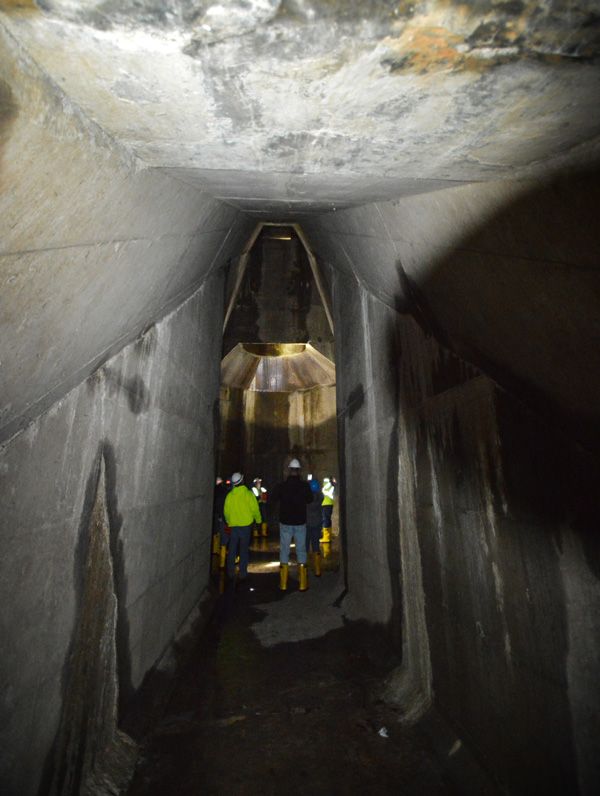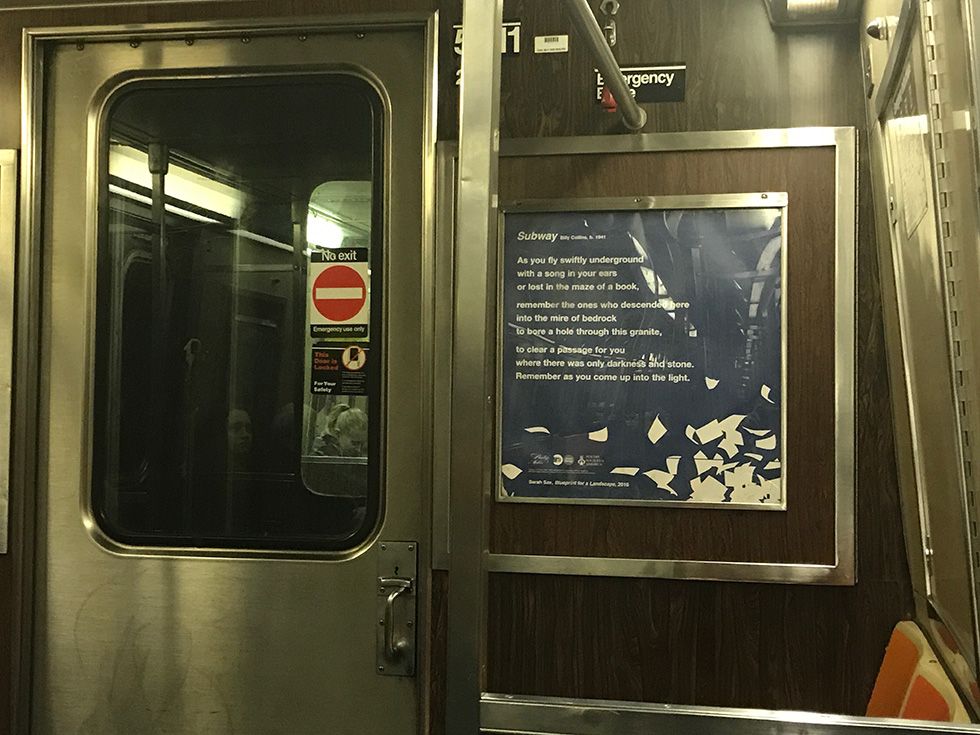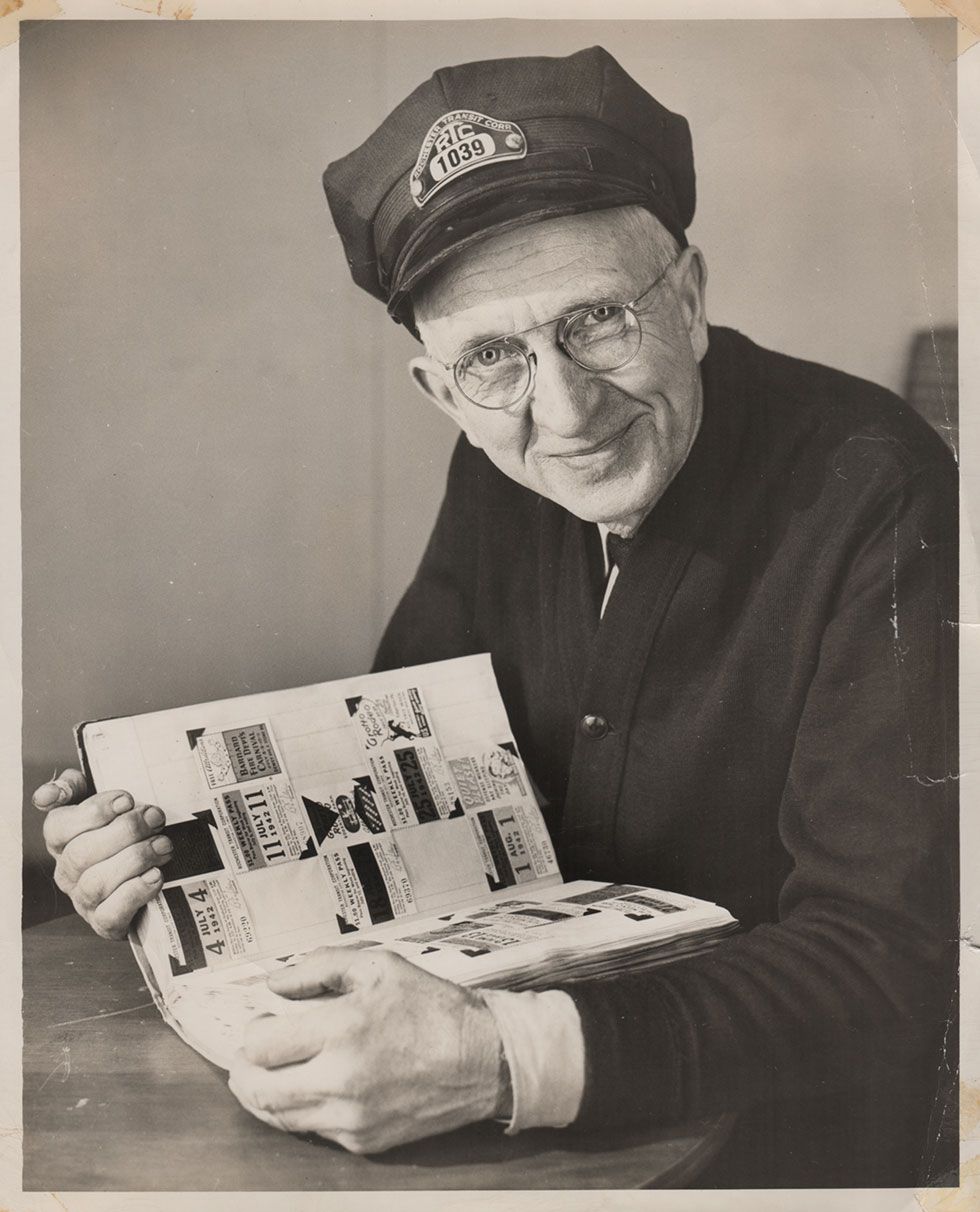This article was scraped from Rochester Subway. This is a blog about Rochester history and urbanism has not been published since 2017. The current owners are now publishing link spam which made me want to preserve this history.. The original article was published April 11, 2015 and can be found here.
![Let's explore Rochester's deep rock sewer tunnels! [PHOTO: RochesterSubway.com]](https://senseofplace.dev/content/images/photos/csoap-deep-rock-sewer-tunnel-rochester-00.jpg)
A few weeks ago we took you on a trip to Van Lare Wastewater Treatment Facility to see where Rochester's dirty water goes to get cleaned up. It was there that we learned of an extensive deep rock tunnel system that that captures major storm runoff until it can be treated. Known as the Combined Sewer Overflow Abatement Program, or CSOAP, this system saves over 1 billion gallons of sewage from overflowing into the Genesee River and Irondequoit Bay each year.
More importantly, this means there are 30 miles of giant smelly tunnels beneath our city just waiting to be explored! Come on let's go...
![Our journey deep inside the bowels of our city begins here, at this unassuming intersection at East Ridge Road in Irondequoit. [PHOTO: RochesterSubway.com]](https://senseofplace.dev/content/images/photos/csoap-deep-rock-sewer-tunnel-rochester-01.jpg)
Our journey deep inside the bowels of our city begins here, at this unassuming intersection at East Ridge Road in Irondequoit. The only indication that anything is even here is this sign for the Culver-Goodman Control Structure. But don't show up uninvited. Bill Putt from Monroe County Pure Waters is letting me tag along on a tunnel inspection today. Jealous?
![After making my way down a long gated driveway, I finally arrive. [PHOTO: RochesterSubway.com]](https://senseofplace.dev/content/images/photos/csoap-deep-rock-sewer-tunnel-rochester-02.jpg)
After making my way down a long gated driveway, I finally arrive.
![And here she is; the Culver-Goodman Control Structure. I know what you're thinking. It just looks like a hole in the ground. And you'd be right. [PHOTO: RochesterSubway.com]](https://senseofplace.dev/content/images/photos/csoap-deep-rock-sewer-tunnel-rochester-03.jpg)
And here she is; the Culver-Goodman Control Structure. I know what you're thinking. It just looks like a hole in the ground. And you'd be right.
![At the top of the photo is Interstate 590. That V-shaped thing is the control structure. At the pointy end of the V is the Culver-Goodman deep rock tunnel opening. And at the wide end of the V is a 50 foot high dam. [PHOTO: RochesterSubway.com]](https://senseofplace.dev/content/images/photos/csoap-deep-rock-sewer-tunnel-rochester-04.jpg)
Here's a better look at it from the air

. At the top of the photo is Interstate 590. That V-shaped thing is the control structure. At the pointy end of the V is the Culver-Goodman deep rock tunnel opening. And at the wide end of the V is a 50 foot high dam. I'll explain more about that in a minute. Let's go in for a closer look.
![The only way to get down inside is to be lowered in by crane. [PHOTO: RochesterSubway.com]](https://senseofplace.dev/content/images/photos/csoap-deep-rock-sewer-tunnel-rochester-05.jpg)
The only way to get down inside is to be lowered in by crane. Oh heck yes... that's TWO things crossed off my bucket list - in one day.
![The view from here is spectacular. Say hi to the boys from Pure Waters. [PHOTO: RochesterSubway.com]](https://senseofplace.dev/content/images/photos/csoap-deep-rock-sewer-tunnel-rochester-06.jpg)
The view from here is spectacular. Say hi to the boys from Pure Waters.
![Almost there. Touch down in T minus 3, 2, 1... [PHOTO: RochesterSubway.com]](https://senseofplace.dev/content/images/photos/csoap-deep-rock-sewer-tunnel-rochester-07.jpg)
Almost there. Touch down in T minus 3, 2, 1...
![Ok, here we are on the surface of Mars. R2-D2 and his family have come to greet us. [PHOTO: RochesterSubway.com]](https://senseofplace.dev/content/images/photos/csoap-deep-rock-sewer-tunnel-rochester-08.jpg)
Ok, here we are on the surface of Mars. R2-D2 and his family have come to greet us.
![Just kidding. We're still on Earth. But trust me, you're still going to want your moon boots for this. [PHOTO: RochesterSubway.com]](https://senseofplace.dev/content/images/photos/csoap-deep-rock-sewer-tunnel-rochester-10.jpg)
Just kidding. We're still on Earth. But trust me, you're still going to want your moon boots for this.
![This is one of just a few access points from where the tunnels can be inspected like this. [PHOTO: RochesterSubway.com]](https://senseofplace.dev/content/images/photos/csoap-deep-rock-sewer-tunnel-rochester-09.jpg)
As I mentioned, there are some 30 miles of these tunnels fanning out beneath Rochester. This is one of just a few access points from where the tunnels can be inspected like this.
![Construction of the tunnel system took 9 years, from 1982 to 1991. [PHOTO: RochesterSubway.com]](https://senseofplace.dev/content/images/photos/csoap-deep-rock-sewer-tunnel-rochester-53.jpg)
Construction of the tunnel system took 9 years, from 1982 to 1991. Documents on the Monroe County web site explain, "Laser-guided tunnel boring machines, called moles, chewed tunnels anywhere from 10 to 16 feet in diameter--at an underground depth of between 85 and 200 feet. The $2.5 Million moles were enormous pieces of equipment. They measured about 400 feet from cutter head to the end of its trailing equipment, where the smashed rock was loaded into rail cars. Approximately thirteen workers tended each mole."
The photo above shows the head of a mole (and its teeth) emerging from a tunnel.
![These tunnels are so wide you can literally drive a truck through them. And that's exactly what we're doing today. [PHOTO: RochesterSubway.com]](https://senseofplace.dev/content/images/photos/csoap-deep-rock-sewer-tunnel-rochester-11.jpg)
These tunnels are so wide you can literally drive a truck through them. And that's exactly what we're doing today.
![Mount up. [PHOTO: RochesterSubway.com]](https://senseofplace.dev/content/images/photos/csoap-deep-rock-sewer-tunnel-rochester-12.jpg)
Mount up.
![As the driver gives it the gas, we're jostled around a bit, and off we go. [PHOTO: RochesterSubway.com]](https://senseofplace.dev/content/images/photos/csoap-deep-rock-sewer-tunnel-rochester-13.jpg)
As the driver gives it the gas, we're jostled around a bit, and off we go.
![There ain't no turning back now. [PHOTO: RochesterSubway.com]](https://senseofplace.dev/content/images/photos/csoap-deep-rock-sewer-tunnel-rochester-14.jpg)
There ain't no turning back now.
![Almost immediately the change in air temperature is striking - it feels like a good 15oF drop in the first few minutes. [PHOTO: RochesterSubway.com]](https://senseofplace.dev/content/images/photos/csoap-deep-rock-sewer-tunnel-rochester-15.jpg)
Almost immediately the change in air temperature is striking - it feels like a good 15oF drop in the first few minutes.
![About a half mile in, Bill checks his air quality monitor. All looks clear today. [PHOTO: RochesterSubway.com]](https://senseofplace.dev/content/images/photos/csoap-deep-rock-sewer-tunnel-rochester-16.jpg)
About a half mile in, Bill looks down to check a device hanging from the truck's rollbar. "What's that?" I shout. "I'm just checking the air quality down here," he yells back. "We shouldn't have any problem today."
That's good, I think to myself.
![Of course, if it weren't for the headlights it'd be pitch dark, but I'm pretty amazed at how clean it looks in here. [PHOTO: RochesterSubway.com]](https://senseofplace.dev/content/images/photos/csoap-deep-rock-sewer-tunnel-rochester-17.jpg)
Of course, if it weren't for the headlights it'd be pitch dark, but I'm pretty amazed at how clean it looks in here.
We had a pretty good rain the night before, so there is still a little stream of water running through the tunnel. Other than that, the space almost seems livable.
![Bill tells me that during major rain events, the tunnels can actually fill all the way up. Suddenly I'm feeling a little anxious. [PHOTO: RochesterSubway.com]](https://senseofplace.dev/content/images/photos/csoap-deep-rock-sewer-tunnel-rochester-18.jpg)
But Bill tells me that during major rain events, the tunnels can actually fill all the way up. Suddenly I'm feeling a little anxious. Checking the weather forecast before venturing in here would be smart.
![After about 5 or 6 minutes we've travelled 1.5 miles in and we come to a fork in the road. Goodman St tunnel on the right; Culver Rd tunnel on the left. [PHOTO: RochesterSubway.com]](https://senseofplace.dev/content/images/photos/csoap-deep-rock-sewer-tunnel-rochester-19.jpg)
After about 5 or 6 minutes we've travelled 1.5 miles in and we come to a fork in the road. If we continue straight we'll head down the Goodman Street branch of the tunnel. Veering left would send us toward Culver Road.
![This is actually our stop. We're going to walk from here. [PHOTO: RochesterSubway.com]](https://senseofplace.dev/content/images/photos/csoap-deep-rock-sewer-tunnel-rochester-20.jpg)
But this is actually our stop. We're going to walk from here.
![As we hop out of our Mercedes and start to stretch our legs, Bill spots something with his flash light... [PHOTO: RochesterSubway.com]](https://senseofplace.dev/content/images/photos/csoap-deep-rock-sewer-tunnel-rochester-21.jpg)
As we hop out of our Mercedes and start to stretch our legs, Bill spots something with his flash light...
![Aww! It's a little brown bat. Cutie! I put him in my pocket and keep him as my pet. I shall name him, Jimmy. [PHOTO: RochesterSubway.com]](https://senseofplace.dev/content/images/photos/csoap-deep-rock-sewer-tunnel-rochester-22.jpg)
Aww! It's a little brown bat. Cutie! I put him in my pocket and keep him as my pet. I shall name him, Jimmy.
![Taking a look around, it's really quite amazing how much space is down here. [PHOTO: RochesterSubway.com]](https://senseofplace.dev/content/images/photos/csoap-deep-rock-sewer-tunnel-rochester-23.jpg)
Taking a look around, it's really quite amazing how much space is down here.
![Judging by the sign, I'd say we're about 80 feet beneath Lyceum Street. [PHOTO: RochesterSubway.com]](https://senseofplace.dev/content/images/photos/csoap-deep-rock-sewer-tunnel-rochester-24.jpg)
Judging by the sign, I'd say we're about 80 feet beneath Lyceum Street

. And now here's where things get interesting.
![We're going to make our way down one of the little off-shoots from the main tunnel. [PHOTO: RochesterSubway.com]](https://senseofplace.dev/content/images/photos/csoap-deep-rock-sewer-tunnel-rochester-25.jpg)
We're going to make our way down one of the little off-shoots from the main tunnel.
![Hmm, things are not quite as spacious as they were in the main tunnel. In fact, this corridor is definitely getting smaller as we continue to walk. [PHOTO: RochesterSubway.com]](https://senseofplace.dev/content/images/photos/csoap-deep-rock-sewer-tunnel-rochester-26.jpg)
Hmm, things are not quite as spacious as they were in the main tunnel. In fact, this corridor is definitely getting smaller as we continue to walk.
![It's strange, but I feel like a somewhat dirty version of Alice in Wonderland. [PHOTO: RochesterSubway.com]](https://senseofplace.dev/content/images/photos/csoap-deep-rock-sewer-tunnel-rochester-28.jpg)
It's strange, but I feel like a somewhat dirty version of Alice in Wonderland.
![Finally I see something up ahead. [PHOTO: RochesterSubway.com]](https://senseofplace.dev/content/images/photos/csoap-deep-rock-sewer-tunnel-rochester-29.jpg)
Finally I see something up ahead.
![The space opens up into a huge concrete chamber--like entering through the big arched doorway of a cathedral--and suddenly I'm having a religious experience. [PHOTO: RochesterSubway.com]](https://senseofplace.dev/content/images/photos/csoap-deep-rock-sewer-tunnel-rochester-30.jpg)
The space opens up into a huge concrete chamber--like entering through the big arched doorway of a cathedral--and suddenly I'm having a religious experience.
![The walls rise up and angle in toward the center like some ancient Pagan temple. And I'm in awe. [PHOTO: RochesterSubway.com]](https://senseofplace.dev/content/images/photos/csoap-deep-rock-sewer-tunnel-rochester-31.jpg)
The walls rise up and angle in toward the center like some ancient Pagan temple. And I'm in awe.
![We're standing at the very bottom of a 50' drop shaft below Lyceum Street. [PHOTO: RochesterSubway.com]](https://senseofplace.dev/content/images/photos/csoap-deep-rock-sewer-tunnel-rochester-32.jpg)
We're standing at the very bottom of a 50' drop shaft below Lyceum Street.
![At the center are two 6' wide openings in the ceiling. [PHOTO: RochesterSubway.com]](https://senseofplace.dev/content/images/photos/csoap-deep-rock-sewer-tunnel-rochester-33.jpg)
At the center are two 6' wide openings in the ceiling.
![Overflow from the surface sewer system travels down this side. [PHOTO: RochesterSubway.com]](https://senseofplace.dev/content/images/photos/csoap-deep-rock-sewer-tunnel-rochester-34.jpg)
Overflow from the surface sewer system travels down this side. Baffles along the inside of the shaft are designed to slow the flow and keep it from making a big loud splash as it hits the floor.
![The other side acts as a vent, regulating air pressure in the pipe to facilitate the flow. [PHOTO: RochesterSubway.com]](https://senseofplace.dev/content/images/photos/csoap-deep-rock-sewer-tunnel-rochester-35.jpg)
The other side acts as a vent, regulating air pressure in the pipe to facilitate the flow.
![A sudden downpour right now would really make my day. [PHOTO: RochesterSubway.com]](https://senseofplace.dev/content/images/photos/csoap-deep-rock-sewer-tunnel-rochester-37.jpg)
It's crazy to think there are close to fifty of these chambers beneath the streets of Rochester and I never had a clue. A sudden downpour right now would really make my day.
Here are a couple of diagrams to help give you some context...
![This diagram shows the 1.5 mile length of our trip (highlighted in pink). [PHOTO: RochesterSubway.com]](https://senseofplace.dev/content/images/photos/csoap-deep-rock-sewer-tunnel-rochester-50.jpg)
This first one shows you the 1.5 mile length of our trip (highlighted in pink). From the Culver-Goodman Control Structure we made our way southwest to drop shaft #9. The purple lines are the tunnels; the purple dots are the chambers.
![Here's the full network. [PHOTO: RochesterSubway.com]](https://senseofplace.dev/content/images/photos/van-lare-water-treatment-plant-rochester-03.jpg)
Here's the full network.
![This is a cross-section of the entire deep rock tunnel system. The area circled in pink represents the section we covered. [PHOTO: RochesterSubway.com]](https://senseofplace.dev/content/images/photos/csoap-deep-rock-sewer-tunnel-rochester-51.jpg)
This is a cross-section of the entire deep rock tunnel system. The area circled in pink represents the section we covered.
![Here is a cut away view of drop shafts under Lyceum Street where our photos were taken. [PHOTO: RochesterSubway.com]](https://senseofplace.dev/content/images/photos/csoap-deep-rock-sewer-tunnel-rochester-52.jpg)
And here is a cut away view of drop shafts under Lyceum Street where our photos were taken.
![So now let's turn around and follow the flow back out, toward the Culver-Goodman Control Structure where we started. [PHOTO: RochesterSubway.com]](https://senseofplace.dev/content/images/photos/csoap-deep-rock-sewer-tunnel-rochester-38.jpg)
So now let's turn around and follow the flow back out, toward the Culver-Goodman Control Structure where we started.
![Remember the 50 foot dam? That's what keeps all of the flow from the Culver and Goodman tunnels from spilling out into Irondequoit Bay. [PHOTO: RochesterSubway.com]](https://senseofplace.dev/content/images/photos/csoap-deep-rock-sewer-tunnel-rochester-39.jpg)
Remember the 50 foot dam? That's what keeps all of the flow from the Culver and Goodman tunnels from spilling out into Irondequoit Bay.
![This giant basin can hold 45 Million gallons of sewage. [PHOTO: RochesterSubway.com]](https://senseofplace.dev/content/images/photos/csoap-deep-rock-sewer-tunnel-rochester-40.jpg)
This giant basin can hold 45 Million gallons of sewage.
![That metal control gate down there leads directly to the Van Lare treatment plant. The gate can release the flow a little bit at a time so as not to overrun the plant. [PHOTO: RochesterSubway.com]](https://senseofplace.dev/content/images/photos/csoap-deep-rock-sewer-tunnel-rochester-41.jpg)
That metal control gate down there leads directly to the Van Lare treatment plant. The gate can release the flow a little bit at a time so as not to overrun the plant.
![But even this massive control system isn't always enough to hold back the tide. Every so often the flow does spill over this 50' dam. [PHOTO: RochesterSubway.com]](https://senseofplace.dev/content/images/photos/csoap-deep-rock-sewer-tunnel-rochester-42.jpg)
But even this massive control system isn't always enough to hold back the tide. Every so often the flow does spill over this 50' dam. The chain link fence on the other side of the dam acts as a screen, keeping large debris from washing into the creek and bay behind it. I'm told on at least one occasion even the fence was wiped out by rushing water.
One tunnel, 45 MILLION gallons of water rushing beneath your feet. Think about that next time it rains.
Anyway, that's pretty much it. I'll leave you with some dull video (above) from our ride through the tunnel. To give you some idea for how wide these tunnels are, at one point in the video the truck does a 3-point turn.
* * *


